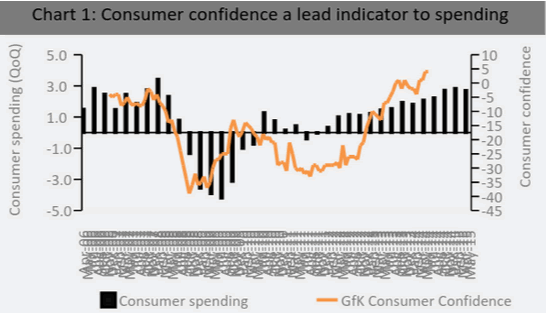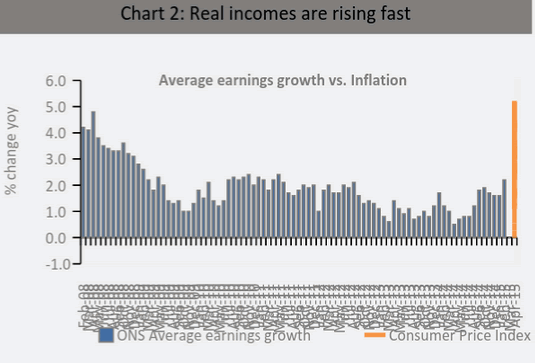Boost in consumer confidence bodes well for the retail sector
Preliminary estimates for GDP in the first quarter of 2015 slowed to 0.3 per cent compared with the previous quarter, down from 0.5 per cent in the last quarter of 2014. While other surveys had indicated a weakening of GDP, the brakes on recovery were a little harsher than we had predicted. With the General Election taking place today 7 May, news that the economic recovery has slowed sharply will not help the coalition parties.
Growth of 0.3 per cent was the slowest quarterly growth since Q4 2012 and suggests that other euro-zone economies may well outpace the UK in Q1 2015. The main drag came from the services sector which grew by a relatively weak 0.5 per cent, down from a 0.9 per cent increase in Q4. From a retail perspective, there is mounting evidence that growth in consumer spending is largely bypassing the retail sector. The latest data showed that the fastest growing components of consumer spending are Transport, Recreation and Culture and Miscellaneous Goods e.g. insurance - all non-retail.
Overall, recent data does suggest a slow-down in the pace of recovery. However, we remain confident that underlying conditions remain strong and suspect that, post-election result, the recovery will return in earnest. The combination of low inflation and rising nominal earnings means that households real incomes are still on course to grow at their fastest rate in over a decade. Consumers are still benefiting from a significant boost in disposable income from the falling price of food, fuel and energy. In addition, despite election uncertainty, both business and consumer confidence remains in good spirits chart 1. The latest figures from GfK puts consumer confidence at a 12-year high suggesting that factors such as job security, house prices and improvements in personal finances are more important than politics. Although both of the forward looking indices, measuring households confidence in their personal finances and general economic situation over the next twelve months, remained steady, they are comfortably above their long-run averages.

Source ONS, Gfk, Retail Economics analysis
Given that confidence remains one of the best predictors of future spending, we believe the recent slow-down will prove to be temporary barring any significant complications with installing the next government.

Source ONS, Gfk, Retail Economics analysis
Average earnings exc. bonuses rose to 2.2 per cent in February, the fastest growth since May 2011. With inflation remaining at zero, real incomes are rising at their fastest rate in over seven years. With the main downward pressures from the CPI basket coming from components that are relatively price insensitive, the scope for additional discretionary spending is large.
House price rises remained steady in April, up by 5.2 per cent year-on-year, the same as the previous month. The housing market over the last six months has slowed from an unsustainable pace quelling fears of another housing bubble. Although mortgage approvals growth stalling in April, we remain confident that changes in stamp duty regulations and strong underlying economic conditions will provide support for the housing market for the remainder of the year and house price rises will begin to accelerate once more. This will help support sales particularly in home and big ticket items such as kitchens and bathrooms.
A boost in household borrowing looks likely for 2015. Positive momentum for borrowing has been brewing in the last six months and with confidence at near all-time high levels, consumer appetite for credit is rising. In absolute terms although household debt rose in Q4, it edged down as a percentage of incomes from 144.5 per cent to 142.9 per cent, well below the levels seen just before the crisis. Households balance sheets are in a much better financial position to take on more debt.
Back to Retail Economic News